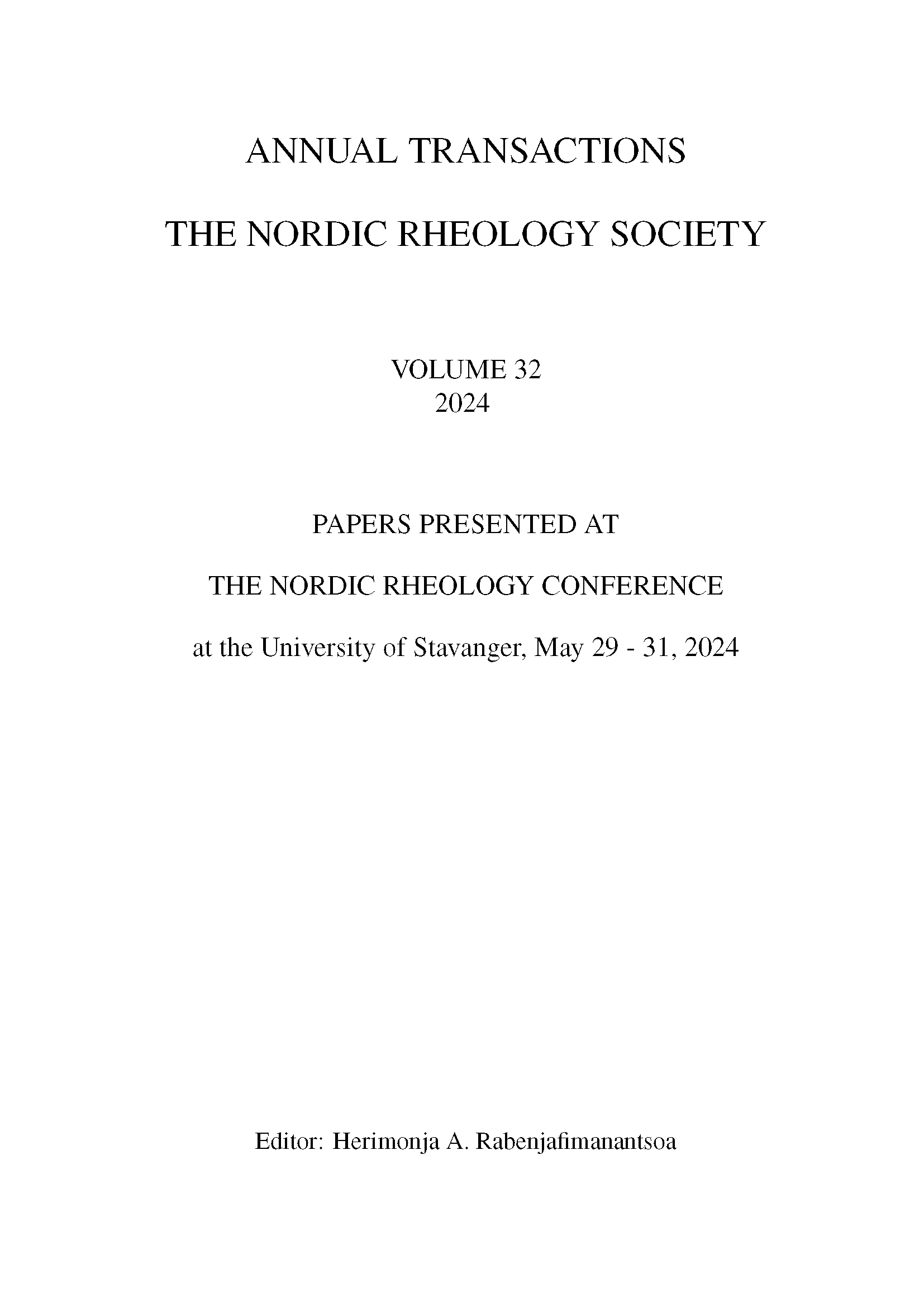Controlling Well Leakage
Rheological and Operational Effects
DOI:
https://doi.org/10.31265/atnrs.781Abstract
Many hydrocarbon wells leak gas, due to shrinkage and other microannuli that typically form along the cement-casing and cement-formation interfaces. These microannuli are variable due to irregularities in the primary cementing process and other operational anomalies. Repair of such defects is via a process called squeeze cementing, that involves pumping a thin cement slurry into the microannulus under pressure. Trudel & Frigaard1 developed a stochastic model of well leakage able to predict all but extreme (high and low) rates of leakage for a median well in British Columbia (BC), Canada, benchmarked against leakage rates observed in 2010-2019. Izadi et al.2,3 have explored the effects of pumping (yield stress) slurries into these narrow irregular geometries, using a Monte-Carlo approach to account for the extreme variability. This enabled us to give probabilistic predictions of the likely effects of the squeeze cementing operation. Here we extend our analysis to different operational scenarios, showing how rheological effects can influence repair of the microannulus.
References
Trudel E., Frigaard I., Stochastic modelling of wellbore leakage in British Columbia. J. Petr. Sci. Engng., 220A, 111199, 2023
https://doi.org/10.1016/j.petrol.2022.111199
Izadi M., Trudel E., Chaparian E., Frigaard I., Squeeze cementing of microannuli: a viscoplastic invasion flow. J. non-Newt. Fluid Mech., 319, 105070, 2023
https://doi.org/10.1016/j.jnnfm.2023.105070
Izadi M., Trudel E., Frigaard I., Risk based analysis of squeeze cementing operations. Geoenergy Sci. Engng., 234, 212687, 2024
https://doi.org/10.1016/j.geoen.2024.212687
Nelson E., Guillot, D., Well cementing. Schlumberger, 2006..
Trudel E., Bizhani M., Zare M., Frigaard I.A., Plug and abandonment practices and trends: A British Columbia perspective. J. Petr. Sci. Engng., 183, 106417, 2019.
https://doi.org/10.1016/j.petrol.2019.106417
Vrålstad T., Saasen A., Fjær E, Øia T., Ytrehus J.D. and Khalifeh M., Plug and abandonment of offshore wells: Ensuring long-term well integrity and cost-efficiency. J. Petr. Sci. Engng., 173, 478--491, 2019.
https://doi.org/10.1016/j.petrol.2018.10.049
Doherty B., Vasylkivska V., Huerta N.J., Dilmore R., Estimating the leakage along wells during geologic CO2 storage: Application of the well leakage assessment tool to a hypothetical storage scenario in Natrona County, Wyoming. Energy Procedia, 114, 5151--5172, 2017.
https://doi.org/10.1016/j.egypro.2017.03.1669
Ford E.P., Moeinikia F., Lohne H.P., Arild O., Mansouri M.M., Fjelde K.K., Leakage calculated for plugged and abandoned wells. Society of Petroleum Engineers, SPE-185890-MS, 2017.
https://doi.org/10.2118/185890-MS
Lackey G., Vasylkivska V.S., Huerta N.J., King S. and Dilmore R.M., Managing well leakage risks at a geologic carbon storage site with many wells. Int. J. Gr. Gas Contr., 88, 182--194. 2019.
https://doi.org/10.1016/j.ijggc.2019.06.011
Willis B.M., Strutt J.E. and Eden R.D., Long term well plug integrity assurance: a probabilistic approach. Offshore Technology Conference OTC-29259-MS, 2019.
https://doi.org/10.4043/29259-MS
White S., Carroll S., Chu S., Bacon D., Pawar R., Cumming L., Hawkins J., Kelley M., Demirkanli I., Middleton R., Sminchak J., Pasumarti A., A risk-based approach to evaluating the area of review and leakage risks at CO2 storage sites. Int. J. Gr. Gas Contr., 93, 102884, 2020.
https://doi.org/10.1016/j.ijggc.2019.102884
Johnson C., Sefat M.H. and Davies D., 2021. Developing a well-centric flow model. The first step in a risk-based approach to oil and gas well decommissioning. J. Petr. Sci. Engng., 204, 108651, 2021.
https://doi.org/10.1016/j.petrol.2021.108651
Al Ramadan M., Salehi S., Aljawad M.S. and Teodoriu C., Numerical modeling of gas migration through cement sheath and microannulus. ACS Omega, 6, 34931--34944, 2021.
https://doi.org/10.1021/acsomega.1c05566
Skorpa R. and Vrålstad T., Visualization of fluid flow through cracks and microannuli in cement sheaths. SPE Journal 23, 2018.
https://doi.org/10.2118/180019-PA
Vrålstad T. and Skorpa, R., Digital cement integrity: a methodology for 3D visualization of cracks and microannuli in well cement. Sustainability, 12, 4128, 2020.
https://doi.org/10.3390/su12104128
Stormont J.C., Garcia Fernandez S., Taha M.R. and Matteo E.N., Gas flow through cement-casing microannuli under varying stress conditions. Geomech. Energy Envir. 13, 1--13. 2018.
https://doi.org/10.1016/j.gete.2017.12.001
Garcia Fernandez S., Matteo E.N., Taha M.R. and Stormont J.C., Characterization of wellbore microannuli. J. Nat. Gas Sci. Engng., 62, 13--25, 2019.
https://doi.org/10.1016/j.jngse.2018.12.003
Corina A.N., Skorpa R., Sangesland S., Vrålstad, T., Simulation of fluid flow through real microannuli geometries. J. Petr. Sci. Engng. 196, 107669, 2021.
https://doi.org/10.1016/j.petrol.2020.107669
Trudel E., Frigaard I., Modeling the effect of operational activity on wellbore integrity and wellbore leakage in British Columbia Geoenergy Sci. Engng., 227, 211850, 2023
https://doi.org/10.1016/j.geoen.2023.211850
Pelipenko S. and Frigaard I., Mud removal and cement placement during primary cementing of an oil well-Part 2; steady-state displacements. J. Engng. Math., 48, 1--26, 2004
https://doi.org/10.1023/B:ENGI.0000009499.63859.f0
Maleki A. and Frigaard I., Primary cementing of oil and gas wells in turbulent and mixed regimes. J. Engng. Math., 107, 201--230, 2017

Downloads
Published
Issue
Section
License
Copyright (c) 2024 Mahdi Izadi, Elizabeth Trudel, Ian Frigaard

This work is licensed under a Creative Commons Attribution 4.0 International License.
